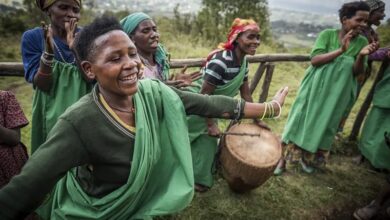Hannibal Barca of Carthage (Tunisia) One of the Greatest Military Strategist in History

In 247 B.C., the year Hannibal Barca was conceived, the Carthage kingdom was around 500 years of age.
Known as one of the best strategist in military history, the battles fought by Hannibal would strike a defining moment throughout the entire existence of the landmass that would be called Africa..
Carthage, Tunisia (North Africa)
Carthage can be located in North Africa close to Tunis.
In his 1961 work, French Historian Gabriel Audisio remarks that he considered “Hannibal to be neither a Phoenician, nor a Carthaginian, nor a Punic, but a North African.
Most of the Punic people appear to have had African or Negroid ancestry.
Whether depicted as Carthaginians, Phoenicians, or Punics of North Africa, as per Audisio’s exploration they were unquestionably a blend of native North Africans that incorporated the local Berbers, Moors, and different ethnic groups.
The Phoenicians were Semitic language people. The English Alphabet was acquired from the Phoenician script.
Their social impact was wide all through the Mediterranean Sea countries. They were known as talented ocean shipper merchants.
They administered in pre-Roman and pre-memorable Iberia (right now Spain and Portugal countries on the Iberian Peninsula), until losing against Rome in the Third Punic War.
The city of Carthage was destroyed by the Romans in 146 BC.
Who Was Hannibal Barca
There is no image of Hannibal in present today. What we in all actuality do have are portrayals of Hannibal by analysts of his time.
According to Roman history, Hannibal was “fearless, completely wise at serious risk, tireless, ready to get through the heat and cold seasons.
He controlled in eating patterns, honest in dress, able to rest enveloped by the military robe, a skillful rider and horseman.”
Hannibal was the child of the Carthage general Hamilcar Barca. He had two siblings: Hasdrubal lived in Spain and Maharbal was captain of Hannibal’s calvary.
Carthage and Rome were at battle during the First Punic War (264-241 B.C.). The two realms were looking for supremacy over the Mediterranean.
Hannibal’s father, Hamilcar Barca, general of the Carthaginian hired fighters, was incensed about the western Mediterranean misfortunes of Sicily and Sardinia.
At the point when Hannibal was 17 years of age, his father was killed in an ambush in Spain.
Hannibal would then take over his father by stepping fully into a military career.
Also Read: How Emperor Menelik II defeated the Italians in the Battle of Adwa, Making Ethiopia the only African Country Never to be Colonized
War Against The Roman Empire
In October 218 B.C., during the Second Punic War, Hannibal had shown up at the Alps.
His fighters are said to have extended for in excess of eight miles at the Alps, the lower regions of the Roman Empire.
Hannibal’s multitude of 100,000 men would trip and battle 1,500 miles to show up at the Alps from Spain.
Hannibal armed forces included Numidians, North Africans from an area generally where Algeria presently draws its limits.
The Numidians were known as expert horsemen who could direct and control their horses with their knees, leaving their hands free to utilize swords and trow javelins.
Hannibal gave this speech to the multitude of men who had survived and crossed the quick streaming Rhone waterway:
“For what reason are you afraid?… Most of our process is achieved. We have overcome the Pyrenees; we have crossed the Rhone, that strong stream, despite the resistance of thousands of Gauls and the fierceness of the waterway.
Presently we have the Alps in sight. On the opposite side of those mountains lies Italy. Does anybody envision the Alps to be everything except what they are- – elevated mountains?
No piece of the earth reaches the sky or is inconceivable to humanity. The Alps produce and support living things. If they are passable by a few men, they are passable to armies.”
Hannibal’s Determination
Hannibal lost half his men in the first 2 weeks into the Alps. Avalanches were ignited by mountain tribes. Men died during hand fight with tribesmen. Starvation and sickness also troubled them.
Hannibal arrived Po Valley with just 26,000 men. At the Po Valley, Hannibal is said to have given a speech once again:
“Soldiers! You have now conquered the bulwarks of Italy, yet additionally Rome. You are entering a friendly amicable nation possessed by people who also hate the Romans however much we do.
The remainder of the journey will be smooth and, after one, or probably a subsequent fight, you will have the fortress and capital of Italy in your control.”
Observers have estimated why Hannibal expressed these words in light of the fact that the men were going to confront the most troublesome aspect of the journey. Companions didn’t anticipate in the Po Valley. Here, the Roman armed force would meet the men in a fight.
The End of Hannibal Barca
By and large, taking into account how far the men had come, there truly was no option but to press onward as of now.
The Carthaginians believed that Rome was planning an invasion of Africa. Hannibal believed he needed to act through an overland assault on Roman to save Carthage.
He would burn through 15 years in Italy, winning many fights like the Battle of Cannae where he lost 6,000 soldiers to Rome’s 70,000 soldiers.
Hannibal didn’t succeed, yet he came close to success. The second of the Punic Wars was finished.
At the point when Hannibal ultimately withdrew with his military to Carthage, his military was crushed by Scipio Africanus in the Battle of Zama.
Continuously looked for by the Romans, when Hannibal was about the age of 64, he was captured and taken to be taken prisoner, he took poison and is recorded to have expressed:
“Let us now put an end to the great anxiety of the Romans.
They have thought it too lengthy and too heavy a task to wait for the death of a hated old man.”





